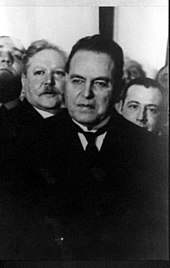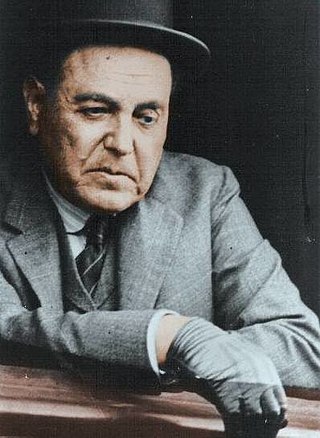
Juan Hipólito del Sagrado Corazón de Jesús Yrigoyen was an Argentine politician of the Radical Civic Union and two-time President of Argentina, who served his first term from 1916 to 1922 and his second term from 1928 to 1930. He was the first president elected democratically by means of the secret and mandatory male suffrage established by the Sáenz Peña Law of 1912. His activism was the prime impetus behind the passage of that law in Argentina.
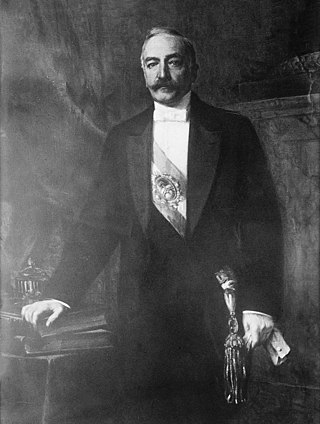
Roque José Antonio del Sagrado Corazón de Jesús Sáenz Peña Lahitte was an Argentine politician and lawyer who served as President of Argentina from 12 October 1910 to his death in office on 9 August 1914. He was the son of former president Luis Sáenz Peña. He was a candidate for an internal, modernist line within the National Autonomist Party.
Argentina held national parliamentary elections on Sunday, 23 October 2005. For the purpose of these elections, each of the 23 provinces and the Autonomous City of Buenos Aires are considered electoral districts.

The Sáenz Peña Law was Law 8871 of Argentina, sanctioned by the National Congress on 10 February 1912, which established the universal, secret and compulsory male suffrage though the creation of an electoral list. It was approved during the presidency of Roque Sáenz Peña, main supporter of the law, and was published in the official government bulletin on 13 February 1912.

The Argentine general election of 1931 was held on 8 November.

The Argentine general election of 1928 was held on 1 April, with a turnout of 80.9%.

The 1922 Argentine general election was held on 2 April 1922, in which Marcelo T. de Alvear was elected to the office of the president representing the Radical Civic Union (UCR). Voter turnout for the election was 55.3%, with the UCR garnering a plurality at 51% of the popular vote and carrying 9 of the 14 provinces of Argentina.
Argentina held nine presidential elections between 1862 and 1910, every six years.

Argentine legislative elections of 1912 were held on 7 April 1912 for the Argentine Chamber of Deputies. The first free, democratic elections in the nation's history, the contest had a turnout of 73%.

The Argentine presidential election of 1937 was held on 5 September 1937.
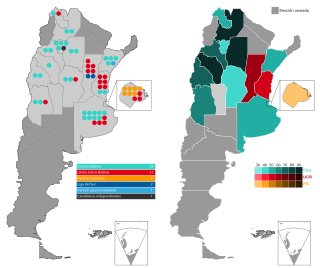
The Argentine legislative elections of 1914 were held on 22 March. Voters chose their legislators, and with a turnout of 58%.

The Argentine legislative elections of 1918 were held on 3 March. Voters chose their legislators and numerous governors, and with a turnout of 56.4%.
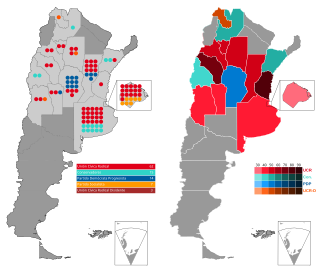
The Argentine legislative elections of 1920 were held on 7 March. Voters chose their legislators and numerous governors, and with a turnout of 53.7%.
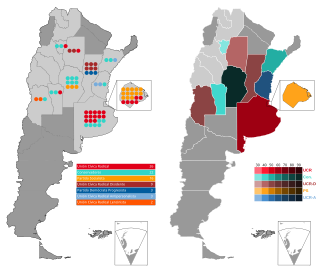
The Argentine legislative elections of 1924 were held on 2 March. Voters chose their legislators and numerous governors, and with a turnout of 44.2%.
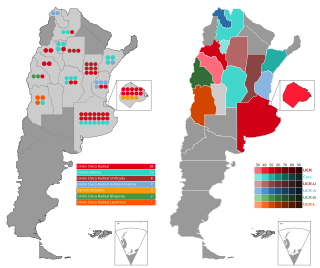
The Argentine legislative elections of 1926 were held on 7 March. Voters chose their legislators and numerous governors, and with a turnout of 49.2%.

Ángel Dolores Rojas was an Argentine lawyer and politician.

The Argentine legislative elections of 1930 were held on 2 March. Voters chose their legislators, with a turnout of 75%.
The Concordancia was a political alliance in Argentina. Three presidents belonging to it, Agustín P. Justo, Roberto Ortiz, and Ramón Castillo were in power from 1931 to 1943, a period known in Argentina as the "Infamous Decade".

The Argentine Revolution of 1893, or the Radical Revolution of 1893, was a failed insurrection by members of the Radical Civic Union (UCR) against the government of Argentina, then controlled by the National Autonomist Party (PAN). It continued the goals of the Revolution of the Park of 1890, whose themes were further echoed in the Revolution of 1905.
The Argentine presidential election of 1910 was held on 13 March to choose the president of Argentina and 63 of 120 seats in the Chamber of Deputies. Roque Sáenz Peña was elected president.





